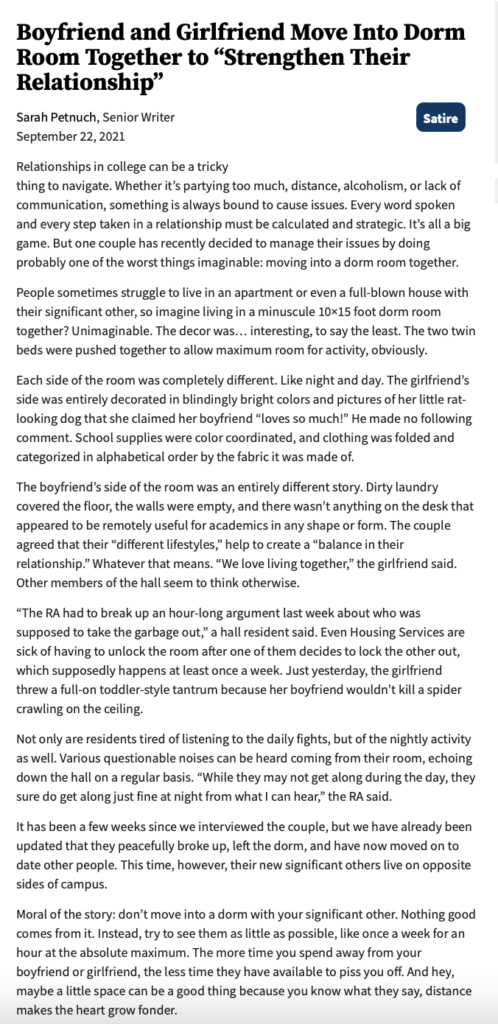Jhoana Flores
While we would all like to believe that we came to college for academics, all college students know that we came for partying and, despite the heartbreaks, the relationships. After a year of not having a say in who you live with, sophomore year at Hamilton promises the opportunity to live with your partner (if you were lucky enough to find one).
Living together as a college couple, as Petnuch expresses, can be the worst decision ever. However, calling it a “bad move” outright is a harsh criticism; even so, this does not completely dismiss the argument that it could be the worst idea. As a college couple expresses, “Sam talked about cohabitation as involving a level commitment that he could hardly imagine in his current relationship: “We’d be sharing everything… the same space all the time. I’m definitely not ready for that and I’m 100, well 99% sure she’s not ready for that” (Jamison and Ganong 2010, 551). I do not wish to sound pessimistic, especially as a romantic, but few people discuss the difficulties of college cohabitation. Questions arise: Who does the place-making? What are the boundaries in a dorm, and how are they enforced?
With home-making being traditionally a gendered notion that typically women do (Young 1997), it necessitates a conversation over who is responsible for things, like garbage and spiders. Many people’s first taste of independence from parental homemaking occurs when they attend college. Therefore, not only is it difficult to learn to take care of one’s own space, but it is especially difficult to do so in Hamilton’s, unfortunate, small dorms.
With little research done to analyze college couples cohabiting in dorms together, this article touches on the main issues. Using the article’s scenario as an example, the two partners have opposing lifestyles, and while the article jokingly assumes gender stereotypes, it emphasizes that students come from diverse backgrounds. And with that, comes partners coming with different understandings of the dynamics of boundaries.
While the couple has divided the space in half, this is ridiculous because it is impractical to not have the inevitable intrusion on personal space. According to the article, conversations about when these boundaries are crossed did not take place, and thus these boundaries are not enforced.
While this may be an exaggerated case, other couples have chosen a different path for cohabitation. “As a comfortable and facilitative alternative for riskier commitments like permanently living together, most college couples who live apart spend anything from three nights to seven nights a week together in order to build a lasting relationship” (Jamison and Ganong 2010, 553). Instead, many students prefer to live in separate dorms. But how is this living separation enforced? Even if each student lives separately, how can each student find a “home” in the space of the others, thereby intersecting place-making and separate spaces?
Well, just as Hughes (Hughes 2019) presents the concept of guesting, this study found that for a couple who had “plans to move in together in the future, they maintained a physical (moving between homes) and mental (behaving as a guest) separation between their residences” (Jamison and Ganong 2010, 548). For many, the separation of spaces provides the “comfort of knowing that you can go back [to your own home” (Jamison and Ganong 2010, 551).
College is a new adventure with the unknown territory, and dating life adds to that. When it comes to feeling safe, whether you are sharing a dorm or moving from dorm to dorm, the decision to live together is not an easy one. Just a word of advice: The walls at Hamilton are very thin, so please respect your fellow neighbor–Boundaries 🙂
Sources:
Hughes, Bethany. 2019. “Guesting on Indigenous Land: Plimoth Plantation, Land Acknowledgment, and Decolonial Praxis.” Theatre Topics 29 (1): E-32; 23. doi:10.1353/tt.2019.0013.
Jamison, Tyler B., and Lawrence Ganong. 2011. “‘‘We’re Not Living Together:’’ Stayover Relationships among College-Educated Emerging Adults.” Journal of Social and Personal Relationships 28 (4): 536-557. doi:10.1177/0265407510384897.
Petnuch, Sarah. “Boyfriend and Girlfriend Move Into Dorm Room Together to “Strengthen Their Relationship”.” The Bucknellian. September 22, 2021. https://bucknellian.net/106074/satire/boyfriend-and-girlfriend-move-into-dorm-room-together-to-strengthen-their-relationship/
Young, Iris Marion. “House and Home: Feminist Variations on a Theme.” In Intersecting Voices: Dilemmas of Gender, Political Philosophy, and Policy, 134–64. Princeton University Press, 1997. https://doi.org/10.2307/j.ctv131bvqj.11.

